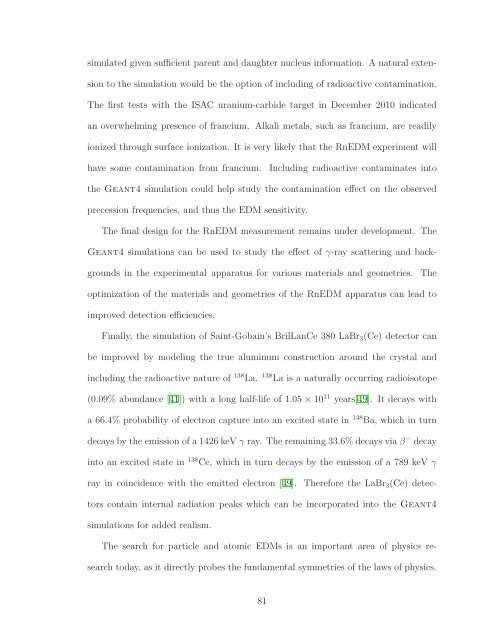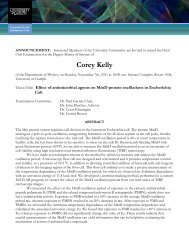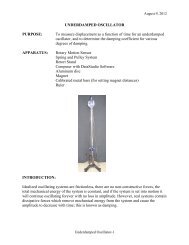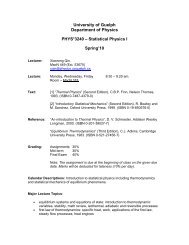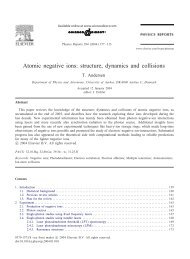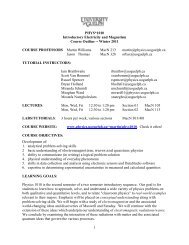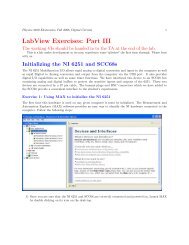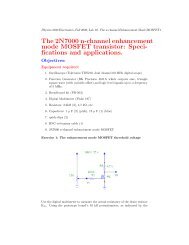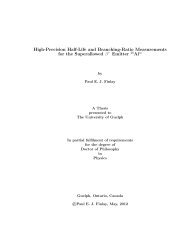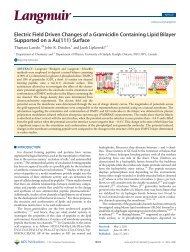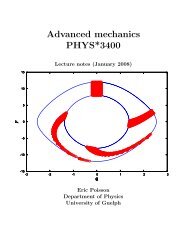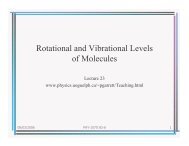Geant4 Simulations for the Radon Electric Dipole Moment Search at
Geant4 Simulations for the Radon Electric Dipole Moment Search at
Geant4 Simulations for the Radon Electric Dipole Moment Search at
You also want an ePaper? Increase the reach of your titles
YUMPU automatically turns print PDFs into web optimized ePapers that Google loves.
simul<strong>at</strong>ed given sufficient parent and daughter nucleus in<strong>for</strong>m<strong>at</strong>ion. A n<strong>at</strong>ural extension<br />
to <strong>the</strong> simul<strong>at</strong>ion would be <strong>the</strong> option of including of radioactive contamin<strong>at</strong>ion.<br />
The first tests with <strong>the</strong> ISAC uranium-carbide target in December 2010 indic<strong>at</strong>ed<br />
an overwhelming presence of francium. Alkali metals, such as francium, are readily<br />
ionized through surface ioniz<strong>at</strong>ion. It is very likely th<strong>at</strong> <strong>the</strong> RnEDM experiment will<br />
have some contamin<strong>at</strong>ion from francium. Including radioactive contamin<strong>at</strong>es into<br />
<strong>the</strong> <strong>Geant4</strong> simul<strong>at</strong>ion could help study <strong>the</strong> contamin<strong>at</strong>ion effect on <strong>the</strong> observed<br />
precession frequencies, and thus <strong>the</strong> EDM sensitivity.<br />
The final design <strong>for</strong> <strong>the</strong> RnEDM measurement remains under development. The<br />
<strong>Geant4</strong> simul<strong>at</strong>ions can be used to study <strong>the</strong> effect of γ-ray sc<strong>at</strong>tering and backgrounds<br />
in <strong>the</strong> experimental appar<strong>at</strong>us <strong>for</strong> various m<strong>at</strong>erials and geometries. The<br />
optimiz<strong>at</strong>ion of <strong>the</strong> m<strong>at</strong>erials and geometries of <strong>the</strong> RnEDM appar<strong>at</strong>us can lead to<br />
improved detection efficiencies.<br />
Finally, <strong>the</strong> simul<strong>at</strong>ion of Saint-Gobain’s BrilLanCe 380 LaBr 3 (Ce) detector can<br />
be improved by modeling <strong>the</strong> true aluminum construction around <strong>the</strong> crystal and<br />
including <strong>the</strong> radioactive n<strong>at</strong>ure of 138 La. 138 La is a n<strong>at</strong>urally occurring radioisotope<br />
(0.09% abundance [41]) with a long half-life of 1.05×10 11 years[49]. It decays with<br />
a 66.4% probability of electron capture into an excited st<strong>at</strong>e in 138 Ba, which in turn<br />
decays by <strong>the</strong> emission of a 1426keV γ ray. The remaining 33.6%decays via β − decay<br />
into an excited st<strong>at</strong>e in 138 Ce, which in turn decays by <strong>the</strong> emission of a 789 keV γ<br />
ray in coincidence with <strong>the</strong> emitted electron [49]. There<strong>for</strong>e <strong>the</strong> LaBr 3 (Ce) detectors<br />
contain internal radi<strong>at</strong>ion peaks which can be incorpor<strong>at</strong>ed into <strong>the</strong> <strong>Geant4</strong><br />
simul<strong>at</strong>ions <strong>for</strong> added realism.<br />
The search <strong>for</strong> particle and <strong>at</strong>omic EDMs is an important area of physics research<br />
today, as it directly probes <strong>the</strong> fundamental symmetries of <strong>the</strong> laws of physics.<br />
81


